Reflective Analysis: Health Standards and Patient Safety in Nursing
VerifiedAdded on 2023/06/07
|9
|2047
|50
AI Summary
This reflective writing assignment details a nursing student's experience during a clinical placement where a patient suffered due to breaches in health standards related to infection control and medication safety. The student reflects on witnessing a colleague's improper practices, including opening dressings with bare hands, failing to sterilize instruments, and administering aspirin to a patient on warfarin, leading to internal hemorrhage and wound infection. The reflection evaluates the breaches against National Healthy Safety and Quality standards, specifically highlighting the importance of infection prevention and medication safety. The student analyzes the negative impacts on the patient and the professional consequences, emphasizing the importance of adhering to health standards to ensure patient safety and quality care. The conclusion outlines the student's commitment to improving their knowledge and skills through further education and training, with a specific action plan to ensure proper infection control and medication administration in future practice. The student aims to prevent similar incidents by following best practices, sterilizing equipment, and thoroughly reviewing patient documentation to avoid drug interactions.
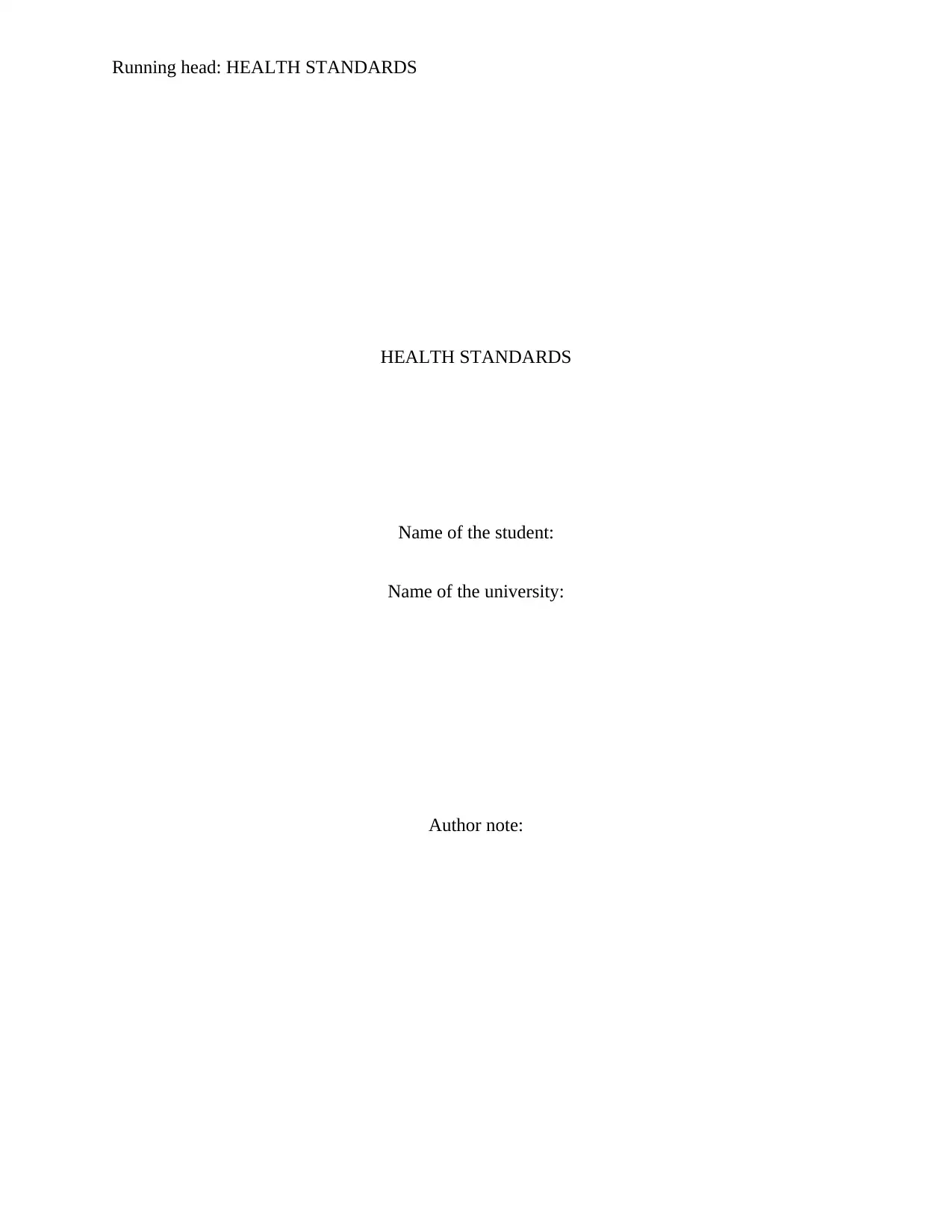
Running head: HEALTH STANDARDS
HEALTH STANDARDS
Name of the student:
Name of the university:
Author note:
HEALTH STANDARDS
Name of the student:
Name of the university:
Author note:
Paraphrase This Document
Need a fresh take? Get an instant paraphrase of this document with our AI Paraphraser
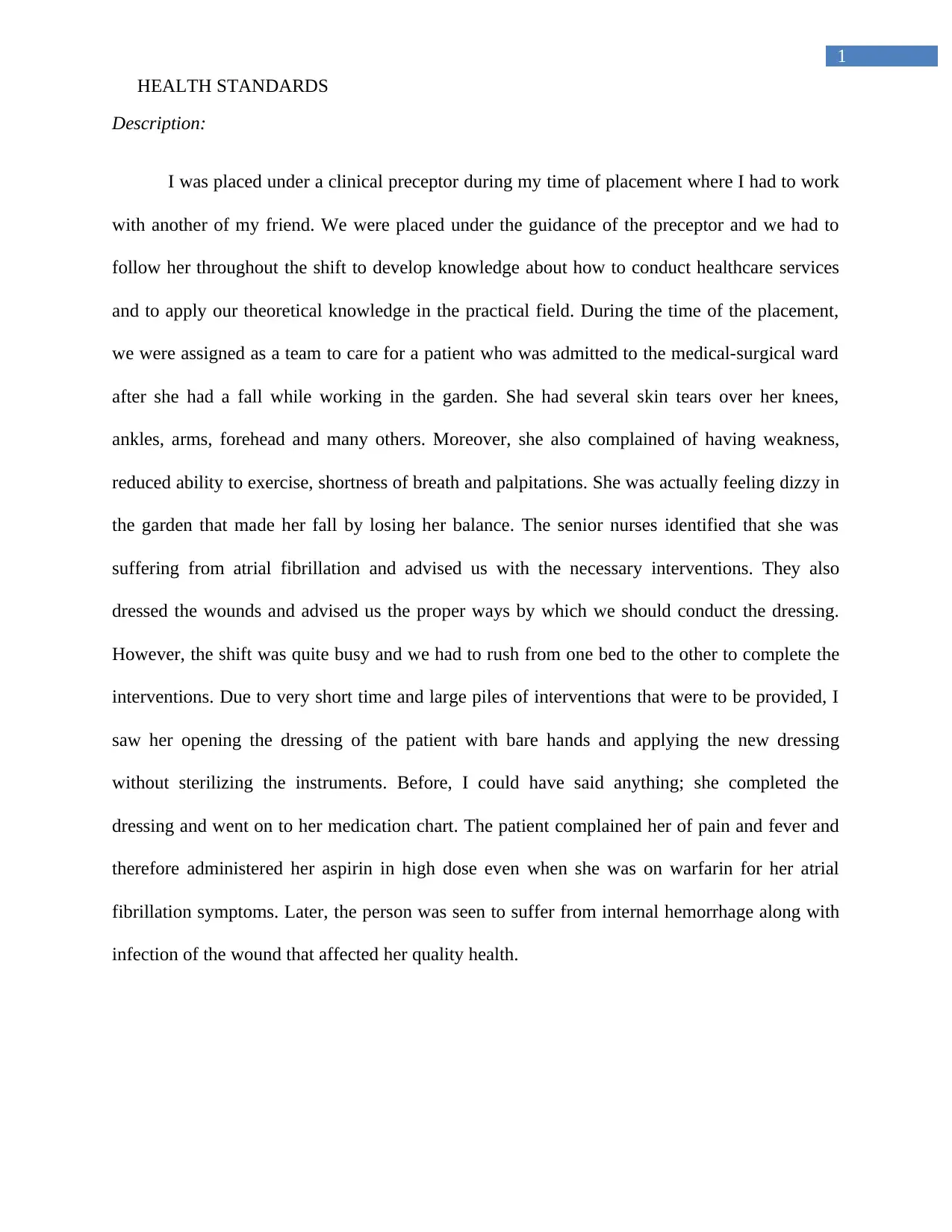
1
HEALTH STANDARDS
Description:
I was placed under a clinical preceptor during my time of placement where I had to work
with another of my friend. We were placed under the guidance of the preceptor and we had to
follow her throughout the shift to develop knowledge about how to conduct healthcare services
and to apply our theoretical knowledge in the practical field. During the time of the placement,
we were assigned as a team to care for a patient who was admitted to the medical-surgical ward
after she had a fall while working in the garden. She had several skin tears over her knees,
ankles, arms, forehead and many others. Moreover, she also complained of having weakness,
reduced ability to exercise, shortness of breath and palpitations. She was actually feeling dizzy in
the garden that made her fall by losing her balance. The senior nurses identified that she was
suffering from atrial fibrillation and advised us with the necessary interventions. They also
dressed the wounds and advised us the proper ways by which we should conduct the dressing.
However, the shift was quite busy and we had to rush from one bed to the other to complete the
interventions. Due to very short time and large piles of interventions that were to be provided, I
saw her opening the dressing of the patient with bare hands and applying the new dressing
without sterilizing the instruments. Before, I could have said anything; she completed the
dressing and went on to her medication chart. The patient complained her of pain and fever and
therefore administered her aspirin in high dose even when she was on warfarin for her atrial
fibrillation symptoms. Later, the person was seen to suffer from internal hemorrhage along with
infection of the wound that affected her quality health.
HEALTH STANDARDS
Description:
I was placed under a clinical preceptor during my time of placement where I had to work
with another of my friend. We were placed under the guidance of the preceptor and we had to
follow her throughout the shift to develop knowledge about how to conduct healthcare services
and to apply our theoretical knowledge in the practical field. During the time of the placement,
we were assigned as a team to care for a patient who was admitted to the medical-surgical ward
after she had a fall while working in the garden. She had several skin tears over her knees,
ankles, arms, forehead and many others. Moreover, she also complained of having weakness,
reduced ability to exercise, shortness of breath and palpitations. She was actually feeling dizzy in
the garden that made her fall by losing her balance. The senior nurses identified that she was
suffering from atrial fibrillation and advised us with the necessary interventions. They also
dressed the wounds and advised us the proper ways by which we should conduct the dressing.
However, the shift was quite busy and we had to rush from one bed to the other to complete the
interventions. Due to very short time and large piles of interventions that were to be provided, I
saw her opening the dressing of the patient with bare hands and applying the new dressing
without sterilizing the instruments. Before, I could have said anything; she completed the
dressing and went on to her medication chart. The patient complained her of pain and fever and
therefore administered her aspirin in high dose even when she was on warfarin for her atrial
fibrillation symptoms. Later, the person was seen to suffer from internal hemorrhage along with
infection of the wound that affected her quality health.
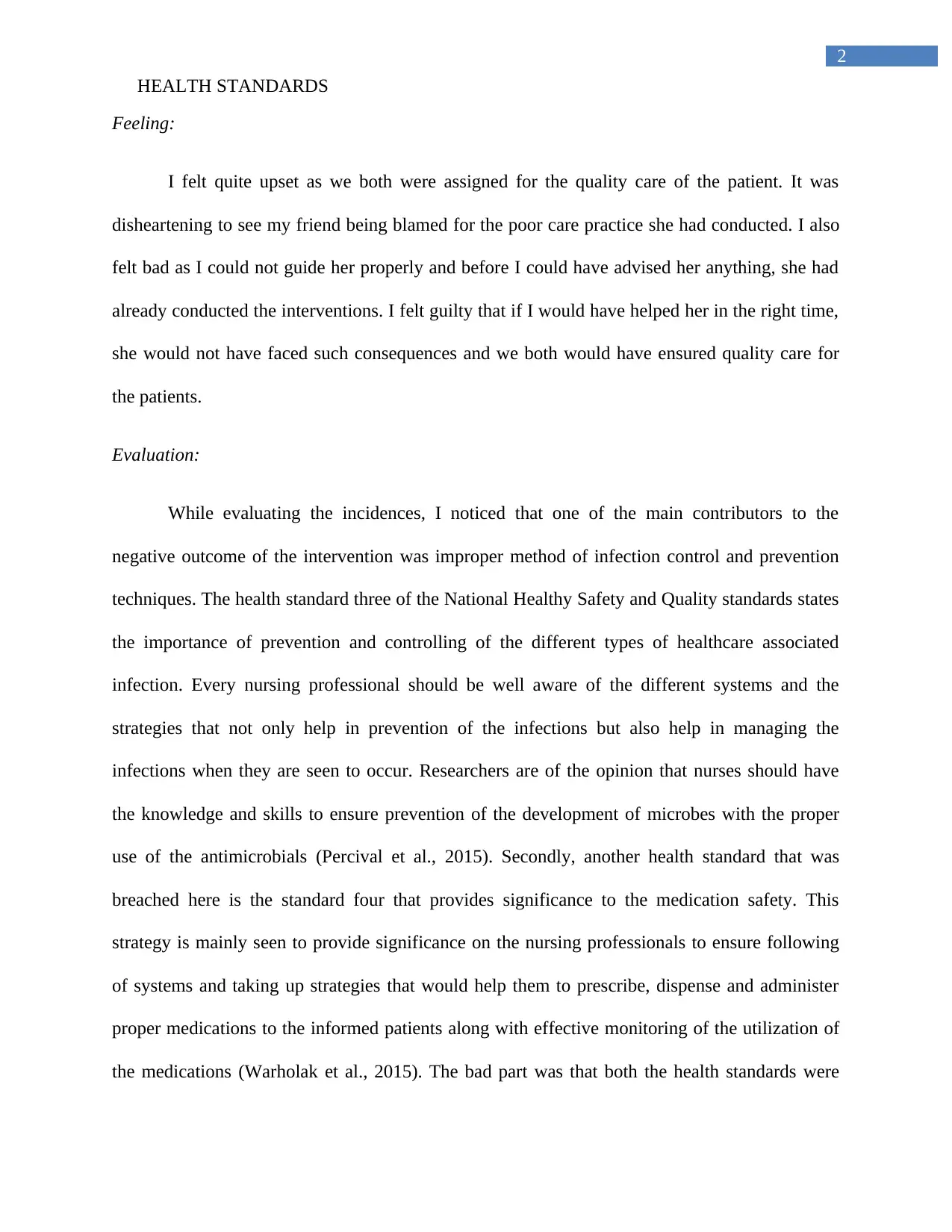
2
HEALTH STANDARDS
Feeling:
I felt quite upset as we both were assigned for the quality care of the patient. It was
disheartening to see my friend being blamed for the poor care practice she had conducted. I also
felt bad as I could not guide her properly and before I could have advised her anything, she had
already conducted the interventions. I felt guilty that if I would have helped her in the right time,
she would not have faced such consequences and we both would have ensured quality care for
the patients.
Evaluation:
While evaluating the incidences, I noticed that one of the main contributors to the
negative outcome of the intervention was improper method of infection control and prevention
techniques. The health standard three of the National Healthy Safety and Quality standards states
the importance of prevention and controlling of the different types of healthcare associated
infection. Every nursing professional should be well aware of the different systems and the
strategies that not only help in prevention of the infections but also help in managing the
infections when they are seen to occur. Researchers are of the opinion that nurses should have
the knowledge and skills to ensure prevention of the development of microbes with the proper
use of the antimicrobials (Percival et al., 2015). Secondly, another health standard that was
breached here is the standard four that provides significance to the medication safety. This
strategy is mainly seen to provide significance on the nursing professionals to ensure following
of systems and taking up strategies that would help them to prescribe, dispense and administer
proper medications to the informed patients along with effective monitoring of the utilization of
the medications (Warholak et al., 2015). The bad part was that both the health standards were
HEALTH STANDARDS
Feeling:
I felt quite upset as we both were assigned for the quality care of the patient. It was
disheartening to see my friend being blamed for the poor care practice she had conducted. I also
felt bad as I could not guide her properly and before I could have advised her anything, she had
already conducted the interventions. I felt guilty that if I would have helped her in the right time,
she would not have faced such consequences and we both would have ensured quality care for
the patients.
Evaluation:
While evaluating the incidences, I noticed that one of the main contributors to the
negative outcome of the intervention was improper method of infection control and prevention
techniques. The health standard three of the National Healthy Safety and Quality standards states
the importance of prevention and controlling of the different types of healthcare associated
infection. Every nursing professional should be well aware of the different systems and the
strategies that not only help in prevention of the infections but also help in managing the
infections when they are seen to occur. Researchers are of the opinion that nurses should have
the knowledge and skills to ensure prevention of the development of microbes with the proper
use of the antimicrobials (Percival et al., 2015). Secondly, another health standard that was
breached here is the standard four that provides significance to the medication safety. This
strategy is mainly seen to provide significance on the nursing professionals to ensure following
of systems and taking up strategies that would help them to prescribe, dispense and administer
proper medications to the informed patients along with effective monitoring of the utilization of
the medications (Warholak et al., 2015). The bad part was that both the health standards were
⊘ This is a preview!⊘
Do you want full access?
Subscribe today to unlock all pages.

Trusted by 1+ million students worldwide
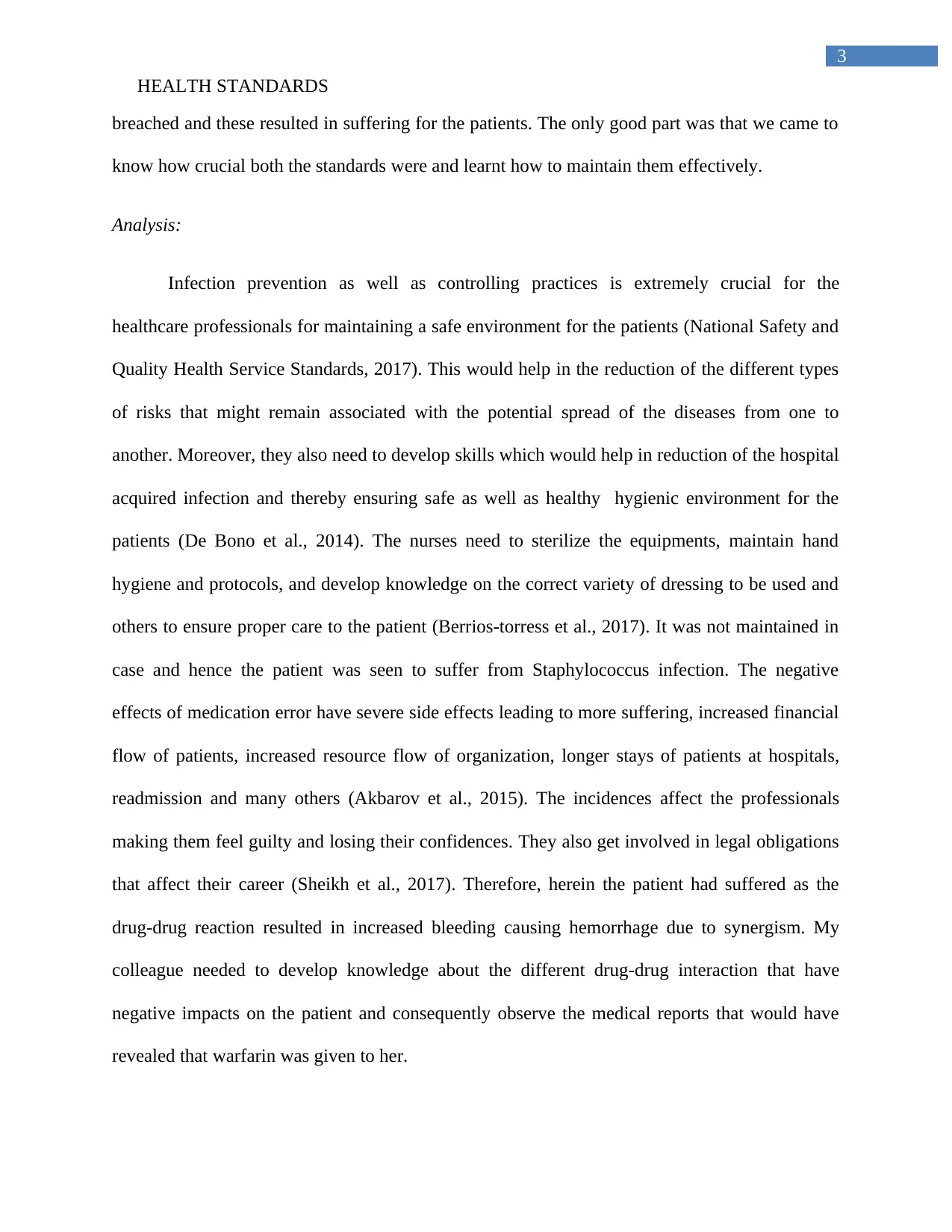
3
HEALTH STANDARDS
breached and these resulted in suffering for the patients. The only good part was that we came to
know how crucial both the standards were and learnt how to maintain them effectively.
Analysis:
Infection prevention as well as controlling practices is extremely crucial for the
healthcare professionals for maintaining a safe environment for the patients (National Safety and
Quality Health Service Standards, 2017). This would help in the reduction of the different types
of risks that might remain associated with the potential spread of the diseases from one to
another. Moreover, they also need to develop skills which would help in reduction of the hospital
acquired infection and thereby ensuring safe as well as healthy hygienic environment for the
patients (De Bono et al., 2014). The nurses need to sterilize the equipments, maintain hand
hygiene and protocols, and develop knowledge on the correct variety of dressing to be used and
others to ensure proper care to the patient (Berrios-torress et al., 2017). It was not maintained in
case and hence the patient was seen to suffer from Staphylococcus infection. The negative
effects of medication error have severe side effects leading to more suffering, increased financial
flow of patients, increased resource flow of organization, longer stays of patients at hospitals,
readmission and many others (Akbarov et al., 2015). The incidences affect the professionals
making them feel guilty and losing their confidences. They also get involved in legal obligations
that affect their career (Sheikh et al., 2017). Therefore, herein the patient had suffered as the
drug-drug reaction resulted in increased bleeding causing hemorrhage due to synergism. My
colleague needed to develop knowledge about the different drug-drug interaction that have
negative impacts on the patient and consequently observe the medical reports that would have
revealed that warfarin was given to her.
HEALTH STANDARDS
breached and these resulted in suffering for the patients. The only good part was that we came to
know how crucial both the standards were and learnt how to maintain them effectively.
Analysis:
Infection prevention as well as controlling practices is extremely crucial for the
healthcare professionals for maintaining a safe environment for the patients (National Safety and
Quality Health Service Standards, 2017). This would help in the reduction of the different types
of risks that might remain associated with the potential spread of the diseases from one to
another. Moreover, they also need to develop skills which would help in reduction of the hospital
acquired infection and thereby ensuring safe as well as healthy hygienic environment for the
patients (De Bono et al., 2014). The nurses need to sterilize the equipments, maintain hand
hygiene and protocols, and develop knowledge on the correct variety of dressing to be used and
others to ensure proper care to the patient (Berrios-torress et al., 2017). It was not maintained in
case and hence the patient was seen to suffer from Staphylococcus infection. The negative
effects of medication error have severe side effects leading to more suffering, increased financial
flow of patients, increased resource flow of organization, longer stays of patients at hospitals,
readmission and many others (Akbarov et al., 2015). The incidences affect the professionals
making them feel guilty and losing their confidences. They also get involved in legal obligations
that affect their career (Sheikh et al., 2017). Therefore, herein the patient had suffered as the
drug-drug reaction resulted in increased bleeding causing hemorrhage due to synergism. My
colleague needed to develop knowledge about the different drug-drug interaction that have
negative impacts on the patient and consequently observe the medical reports that would have
revealed that warfarin was given to her.
Paraphrase This Document
Need a fresh take? Get an instant paraphrase of this document with our AI Paraphraser
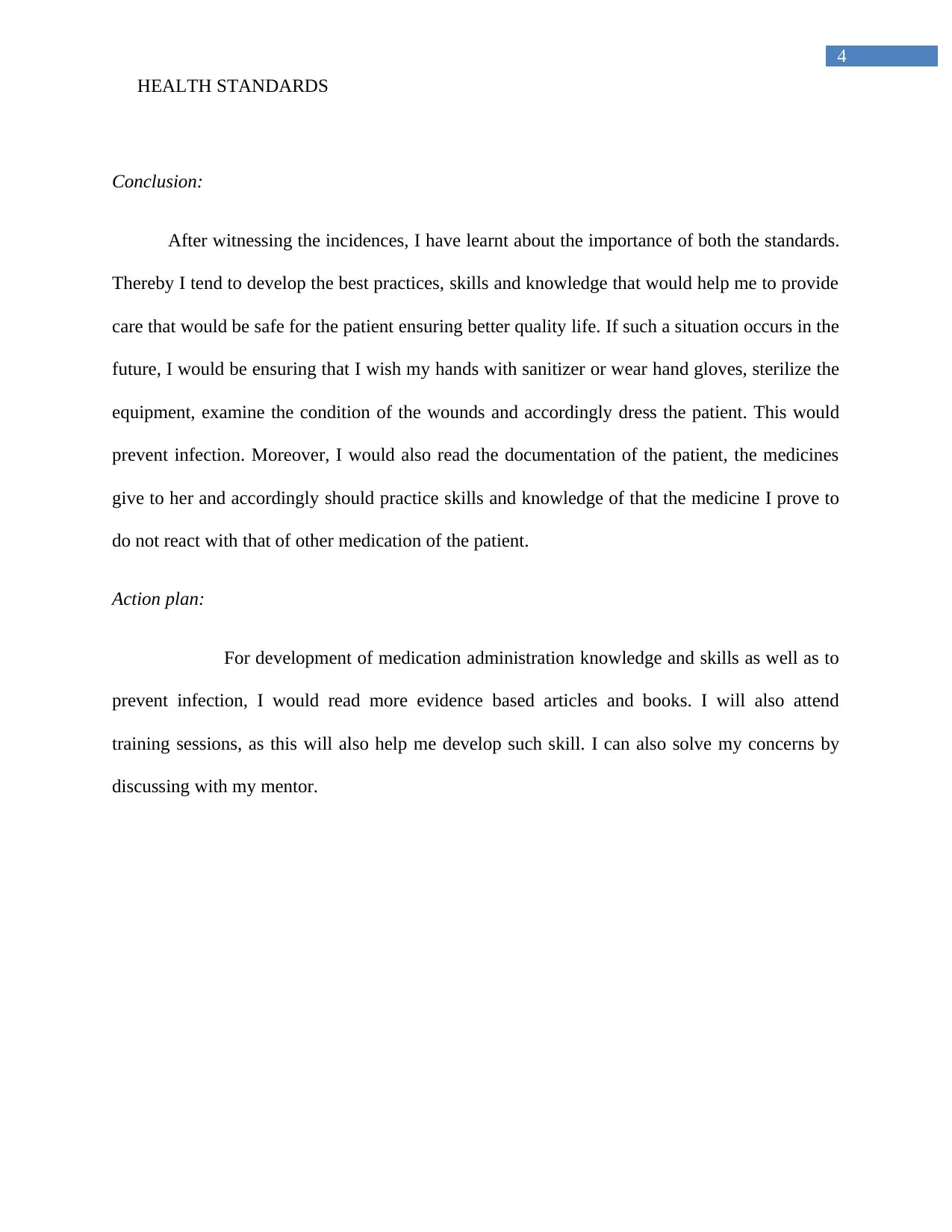
4
HEALTH STANDARDS
Conclusion:
After witnessing the incidences, I have learnt about the importance of both the standards.
Thereby I tend to develop the best practices, skills and knowledge that would help me to provide
care that would be safe for the patient ensuring better quality life. If such a situation occurs in the
future, I would be ensuring that I wish my hands with sanitizer or wear hand gloves, sterilize the
equipment, examine the condition of the wounds and accordingly dress the patient. This would
prevent infection. Moreover, I would also read the documentation of the patient, the medicines
give to her and accordingly should practice skills and knowledge of that the medicine I prove to
do not react with that of other medication of the patient.
Action plan:
For development of medication administration knowledge and skills as well as to
prevent infection, I would read more evidence based articles and books. I will also attend
training sessions, as this will also help me develop such skill. I can also solve my concerns by
discussing with my mentor.
HEALTH STANDARDS
Conclusion:
After witnessing the incidences, I have learnt about the importance of both the standards.
Thereby I tend to develop the best practices, skills and knowledge that would help me to provide
care that would be safe for the patient ensuring better quality life. If such a situation occurs in the
future, I would be ensuring that I wish my hands with sanitizer or wear hand gloves, sterilize the
equipment, examine the condition of the wounds and accordingly dress the patient. This would
prevent infection. Moreover, I would also read the documentation of the patient, the medicines
give to her and accordingly should practice skills and knowledge of that the medicine I prove to
do not react with that of other medication of the patient.
Action plan:
For development of medication administration knowledge and skills as well as to
prevent infection, I would read more evidence based articles and books. I will also attend
training sessions, as this will also help me develop such skill. I can also solve my concerns by
discussing with my mentor.
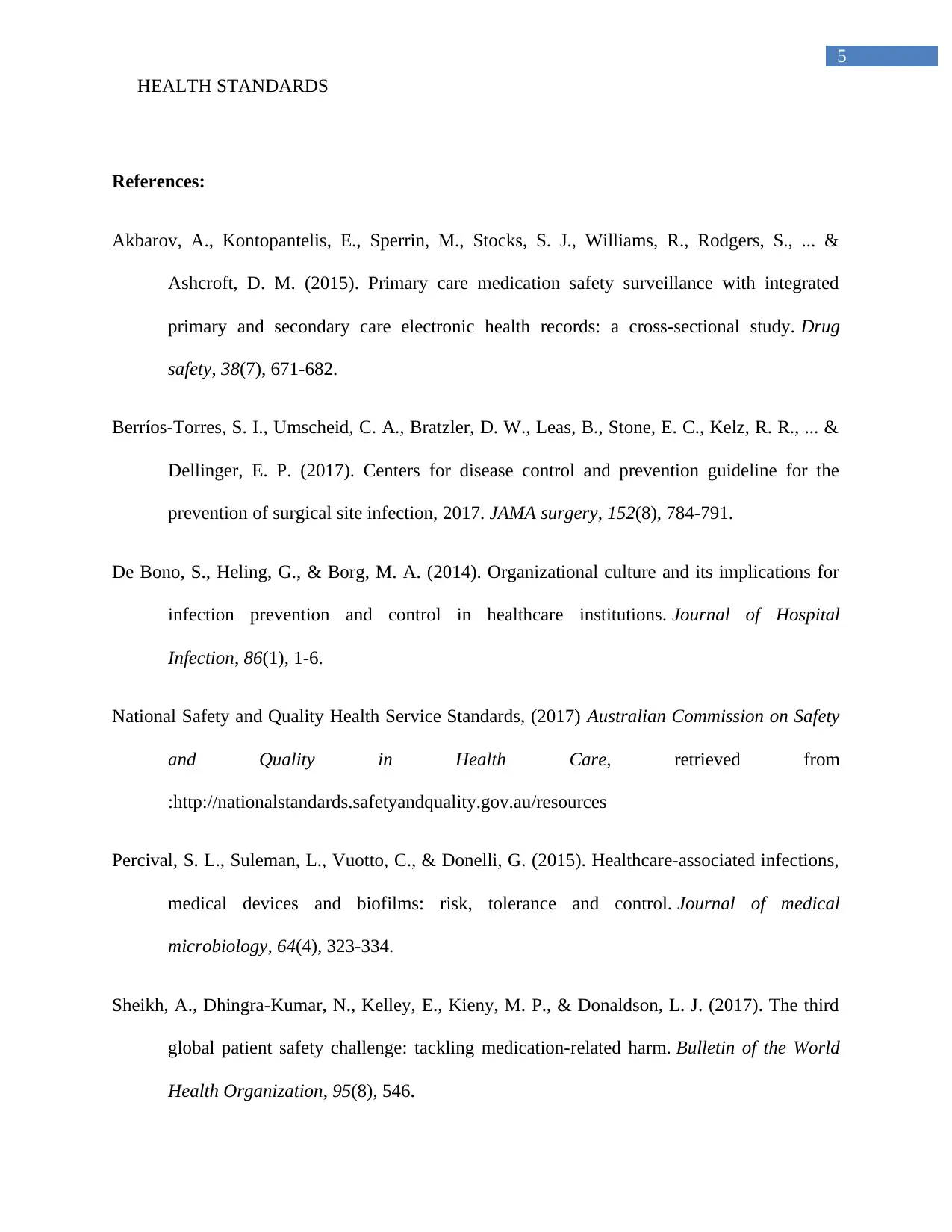
5
HEALTH STANDARDS
References:
Akbarov, A., Kontopantelis, E., Sperrin, M., Stocks, S. J., Williams, R., Rodgers, S., ... &
Ashcroft, D. M. (2015). Primary care medication safety surveillance with integrated
primary and secondary care electronic health records: a cross-sectional study. Drug
safety, 38(7), 671-682.
Berríos-Torres, S. I., Umscheid, C. A., Bratzler, D. W., Leas, B., Stone, E. C., Kelz, R. R., ... &
Dellinger, E. P. (2017). Centers for disease control and prevention guideline for the
prevention of surgical site infection, 2017. JAMA surgery, 152(8), 784-791.
De Bono, S., Heling, G., & Borg, M. A. (2014). Organizational culture and its implications for
infection prevention and control in healthcare institutions. Journal of Hospital
Infection, 86(1), 1-6.
National Safety and Quality Health Service Standards, (2017) Australian Commission on Safety
and Quality in Health Care, retrieved from
:http://nationalstandards.safetyandquality.gov.au/resources
Percival, S. L., Suleman, L., Vuotto, C., & Donelli, G. (2015). Healthcare-associated infections,
medical devices and biofilms: risk, tolerance and control. Journal of medical
microbiology, 64(4), 323-334.
Sheikh, A., Dhingra-Kumar, N., Kelley, E., Kieny, M. P., & Donaldson, L. J. (2017). The third
global patient safety challenge: tackling medication-related harm. Bulletin of the World
Health Organization, 95(8), 546.
HEALTH STANDARDS
References:
Akbarov, A., Kontopantelis, E., Sperrin, M., Stocks, S. J., Williams, R., Rodgers, S., ... &
Ashcroft, D. M. (2015). Primary care medication safety surveillance with integrated
primary and secondary care electronic health records: a cross-sectional study. Drug
safety, 38(7), 671-682.
Berríos-Torres, S. I., Umscheid, C. A., Bratzler, D. W., Leas, B., Stone, E. C., Kelz, R. R., ... &
Dellinger, E. P. (2017). Centers for disease control and prevention guideline for the
prevention of surgical site infection, 2017. JAMA surgery, 152(8), 784-791.
De Bono, S., Heling, G., & Borg, M. A. (2014). Organizational culture and its implications for
infection prevention and control in healthcare institutions. Journal of Hospital
Infection, 86(1), 1-6.
National Safety and Quality Health Service Standards, (2017) Australian Commission on Safety
and Quality in Health Care, retrieved from
:http://nationalstandards.safetyandquality.gov.au/resources
Percival, S. L., Suleman, L., Vuotto, C., & Donelli, G. (2015). Healthcare-associated infections,
medical devices and biofilms: risk, tolerance and control. Journal of medical
microbiology, 64(4), 323-334.
Sheikh, A., Dhingra-Kumar, N., Kelley, E., Kieny, M. P., & Donaldson, L. J. (2017). The third
global patient safety challenge: tackling medication-related harm. Bulletin of the World
Health Organization, 95(8), 546.
⊘ This is a preview!⊘
Do you want full access?
Subscribe today to unlock all pages.

Trusted by 1+ million students worldwide
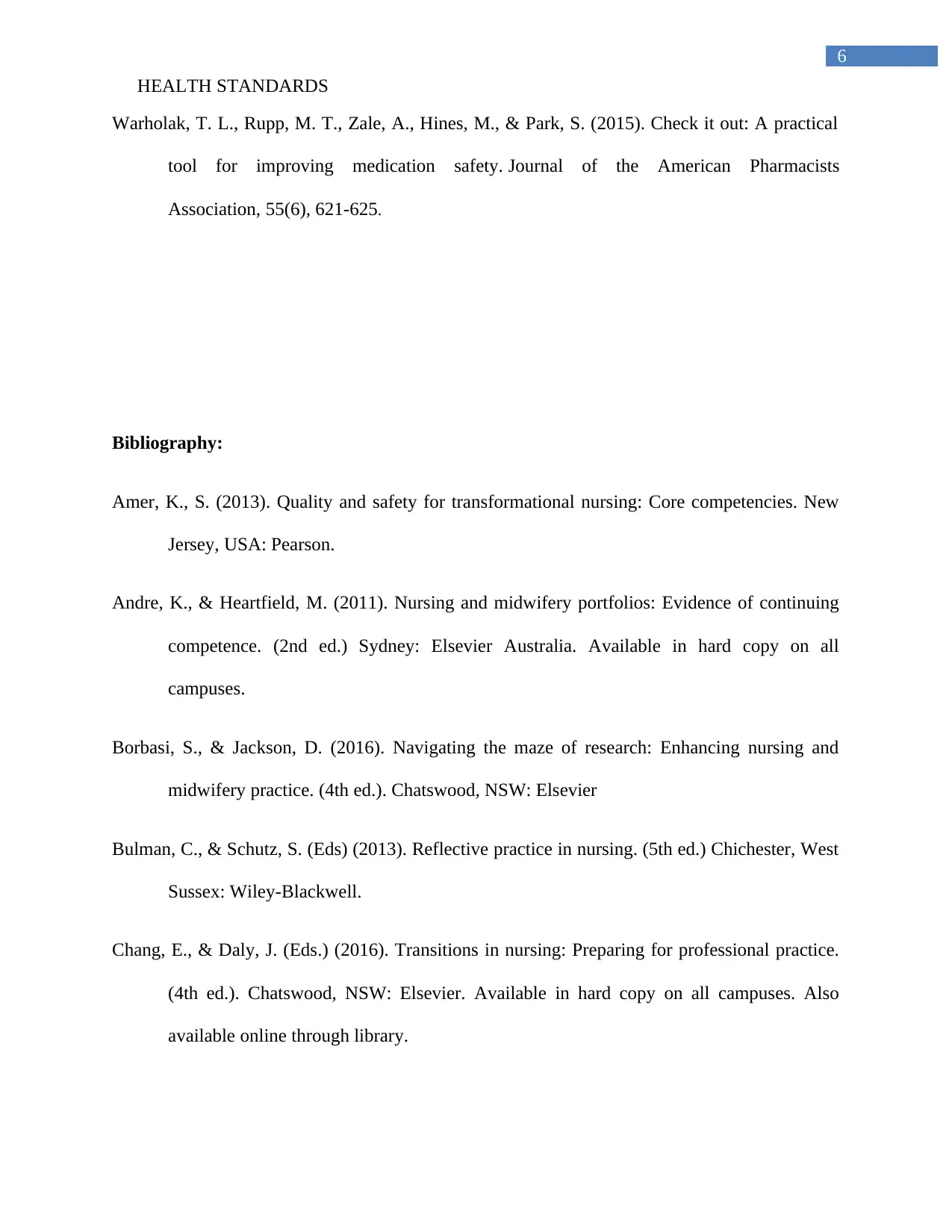
6
HEALTH STANDARDS
Warholak, T. L., Rupp, M. T., Zale, A., Hines, M., & Park, S. (2015). Check it out: A practical
tool for improving medication safety. Journal of the American Pharmacists
Association, 55(6), 621-625.
Bibliography:
Amer, K., S. (2013). Quality and safety for transformational nursing: Core competencies. New
Jersey, USA: Pearson.
Andre, K., & Heartfield, M. (2011). Nursing and midwifery portfolios: Evidence of continuing
competence. (2nd ed.) Sydney: Elsevier Australia. Available in hard copy on all
campuses.
Borbasi, S., & Jackson, D. (2016). Navigating the maze of research: Enhancing nursing and
midwifery practice. (4th ed.). Chatswood, NSW: Elsevier
Bulman, C., & Schutz, S. (Eds) (2013). Reflective practice in nursing. (5th ed.) Chichester, West
Sussex: Wiley-Blackwell.
Chang, E., & Daly, J. (Eds.) (2016). Transitions in nursing: Preparing for professional practice.
(4th ed.). Chatswood, NSW: Elsevier. Available in hard copy on all campuses. Also
available online through library.
HEALTH STANDARDS
Warholak, T. L., Rupp, M. T., Zale, A., Hines, M., & Park, S. (2015). Check it out: A practical
tool for improving medication safety. Journal of the American Pharmacists
Association, 55(6), 621-625.
Bibliography:
Amer, K., S. (2013). Quality and safety for transformational nursing: Core competencies. New
Jersey, USA: Pearson.
Andre, K., & Heartfield, M. (2011). Nursing and midwifery portfolios: Evidence of continuing
competence. (2nd ed.) Sydney: Elsevier Australia. Available in hard copy on all
campuses.
Borbasi, S., & Jackson, D. (2016). Navigating the maze of research: Enhancing nursing and
midwifery practice. (4th ed.). Chatswood, NSW: Elsevier
Bulman, C., & Schutz, S. (Eds) (2013). Reflective practice in nursing. (5th ed.) Chichester, West
Sussex: Wiley-Blackwell.
Chang, E., & Daly, J. (Eds.) (2016). Transitions in nursing: Preparing for professional practice.
(4th ed.). Chatswood, NSW: Elsevier. Available in hard copy on all campuses. Also
available online through library.
Paraphrase This Document
Need a fresh take? Get an instant paraphrase of this document with our AI Paraphraser
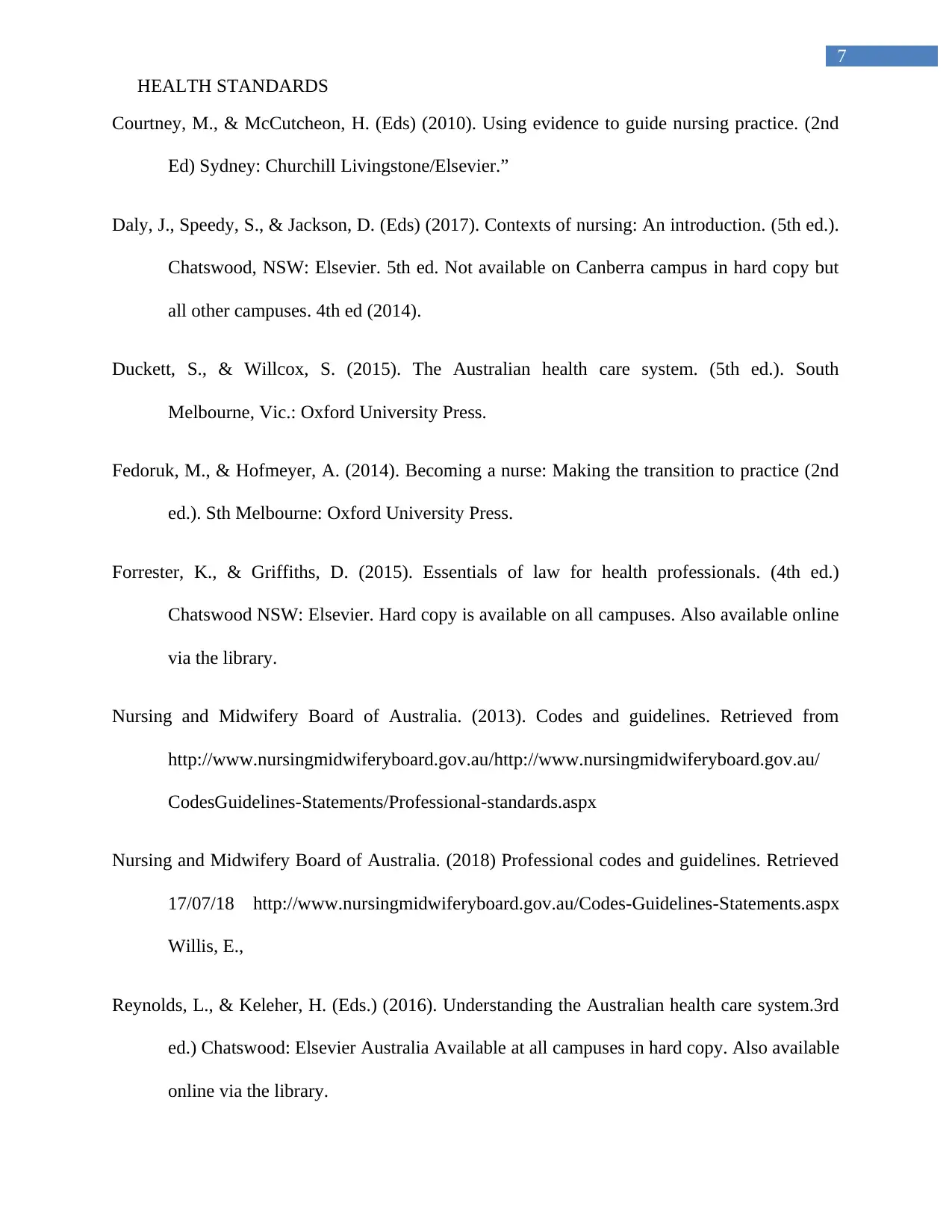
7
HEALTH STANDARDS
Courtney, M., & McCutcheon, H. (Eds) (2010). Using evidence to guide nursing practice. (2nd
Ed) Sydney: Churchill Livingstone/Elsevier.”
Daly, J., Speedy, S., & Jackson, D. (Eds) (2017). Contexts of nursing: An introduction. (5th ed.).
Chatswood, NSW: Elsevier. 5th ed. Not available on Canberra campus in hard copy but
all other campuses. 4th ed (2014).
Duckett, S., & Willcox, S. (2015). The Australian health care system. (5th ed.). South
Melbourne, Vic.: Oxford University Press.
Fedoruk, M., & Hofmeyer, A. (2014). Becoming a nurse: Making the transition to practice (2nd
ed.). Sth Melbourne: Oxford University Press.
Forrester, K., & Griffiths, D. (2015). Essentials of law for health professionals. (4th ed.)
Chatswood NSW: Elsevier. Hard copy is available on all campuses. Also available online
via the library.
Nursing and Midwifery Board of Australia. (2013). Codes and guidelines. Retrieved from
http://www.nursingmidwiferyboard.gov.au/http://www.nursingmidwiferyboard.gov.au/
CodesGuidelines-Statements/Professional-standards.aspx
Nursing and Midwifery Board of Australia. (2018) Professional codes and guidelines. Retrieved
17/07/18 http://www.nursingmidwiferyboard.gov.au/Codes-Guidelines-Statements.aspx
Willis, E.,
Reynolds, L., & Keleher, H. (Eds.) (2016). Understanding the Australian health care system.3rd
ed.) Chatswood: Elsevier Australia Available at all campuses in hard copy. Also available
online via the library.
HEALTH STANDARDS
Courtney, M., & McCutcheon, H. (Eds) (2010). Using evidence to guide nursing practice. (2nd
Ed) Sydney: Churchill Livingstone/Elsevier.”
Daly, J., Speedy, S., & Jackson, D. (Eds) (2017). Contexts of nursing: An introduction. (5th ed.).
Chatswood, NSW: Elsevier. 5th ed. Not available on Canberra campus in hard copy but
all other campuses. 4th ed (2014).
Duckett, S., & Willcox, S. (2015). The Australian health care system. (5th ed.). South
Melbourne, Vic.: Oxford University Press.
Fedoruk, M., & Hofmeyer, A. (2014). Becoming a nurse: Making the transition to practice (2nd
ed.). Sth Melbourne: Oxford University Press.
Forrester, K., & Griffiths, D. (2015). Essentials of law for health professionals. (4th ed.)
Chatswood NSW: Elsevier. Hard copy is available on all campuses. Also available online
via the library.
Nursing and Midwifery Board of Australia. (2013). Codes and guidelines. Retrieved from
http://www.nursingmidwiferyboard.gov.au/http://www.nursingmidwiferyboard.gov.au/
CodesGuidelines-Statements/Professional-standards.aspx
Nursing and Midwifery Board of Australia. (2018) Professional codes and guidelines. Retrieved
17/07/18 http://www.nursingmidwiferyboard.gov.au/Codes-Guidelines-Statements.aspx
Willis, E.,
Reynolds, L., & Keleher, H. (Eds.) (2016). Understanding the Australian health care system.3rd
ed.) Chatswood: Elsevier Australia Available at all campuses in hard copy. Also available
online via the library.
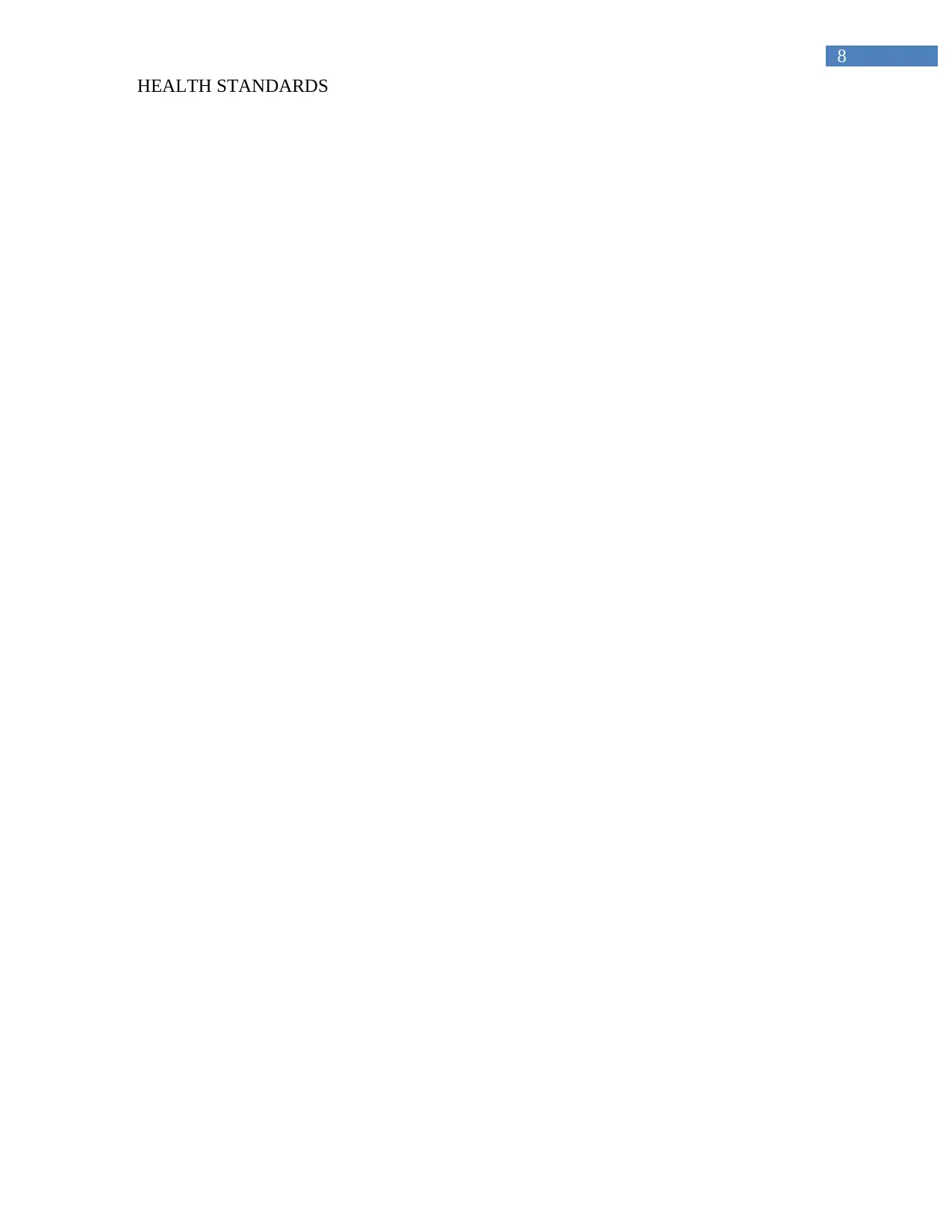
8
HEALTH STANDARDS
HEALTH STANDARDS
⊘ This is a preview!⊘
Do you want full access?
Subscribe today to unlock all pages.

Trusted by 1+ million students worldwide
1 out of 9
Related Documents
Your All-in-One AI-Powered Toolkit for Academic Success.
+13062052269
info@desklib.com
Available 24*7 on WhatsApp / Email
![[object Object]](/_next/static/media/star-bottom.7253800d.svg)
Unlock your academic potential
Copyright © 2020–2025 A2Z Services. All Rights Reserved. Developed and managed by ZUCOL.





